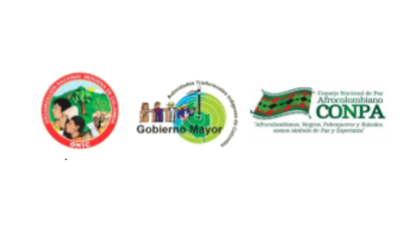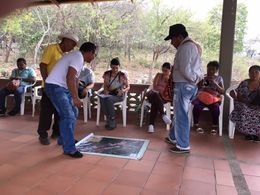PBI Colombia, 13 November 2012
A country at peace does not build itself up from the top; it is the people who have suffered the harshness of war, exclusion and poverty who open the doors for peace. They know that the conflict in this country goes further than the conflict of war and that the construction of social justice is imperative. [1]
This is how the Joint Social Route for Peace (Ruta Social Común para la Paz) presents itself, a space where various regional and national initiatives from the Colombian popular and social movement come together. This space was officially born on the 4th of October 2012 and is the result of various meetings held in different parts of the country during the last two years. Among these stand out the National Land, Territory and Sovereignties Congress; [2] the National Meeting of Peasant Communities, Afro-Colombians and the Indigenous for Land and Peace in Colombia; [3] and the humanitarian visit that took place in Cauca following the uprising of the indigenous communities. [4]
The Route is the reaction of the Colombian popular and social movement to the announcement of official negotiations between the Colombian Government and the guerrilla army, the Armed Revolutionary Forces of Colombia (FARC), on the 4th of September 2012. [5] The Route aims to articulate the different initiatives from within civil society that make possible a united movement for peace that does not allow this brave process to go backwards and that the aspirations of the Colombian people are at the centre of the negotiated solutions. [6] With this aim, the organizations that participate in this process meet twice a week to debate advances in negotiations and participation proposals, as well as to define activities in their own agenda that look to influence the talks between the government and the FARC.
The Route convened a Great National Day on the 5th of October to accompany the negotiations between the government and the FARC. Starting in the early hours, Bogotás National Park was witness to the arrival of hundreds of protesters from various social and political organizations and platforms who answered the call. In this context, Carlos García of the Marcha Patriótica expressed, we are going for a political and negotiated solution to the social and armed conflict, for a lasting peace with social justice, and for the construction of a broad process that allows social and popular participation for a new country. We demand guarantees for the integrity of all the social processes committed to this dream. [7]
The day culminated in the Plaza Bolívar with musical acts and speeches by representatives of the participating organizations. It was carried out as part of the Week of Indignation- Unitarian Action of Organized Resistance and Struggle convened by three coalitions of organizations that were the driving force being the Social Route. [8] These coalitions are the product of coordination work over the past few years which bring together numerous peace-building experiences and grassroots political alternatives. These are: the Congreso de los Pueblos; the Marcha Patriótica and the Coalición de Movimientos y Organizaciones Sociales en Colombia (Comosoc).
In the 50 plus years of armed conflict that Colombia has lived, the Route is not the first initiative that tries to construct a shared space for the social and popular movement in support of a negotiated way out of the war and the construction of peace. According to the NGO International Alert, Colombia is the society with the highest number of peace initiatives in the world. [9] For example, since 1994 the Catholic Church has organized the National Conciliation Commission, which in 2011 produced the National Agreement for Reconciliation and Peace in Colombia;[10] the Permanent Assembly of Civil Society for Peace, a pedagogic process that since 1998 works for a politically negotiated solution to the armed conflict and for a peace with social justice; [11] and the Planet Peace project has been developing a Minimum Agenda for Peace since 2000, together with popular social organizations from various parts of the country. [12]
Organizations like the Center for Research and Popular Education (Cinep) and the Inter-Church Justice and Peace Commission (CIJP) have supported rural community resistance processes in various parts of the country since the end of the 90s. These processes have led to the creation of the Peace Communities[13] (like that of San José de Apartadó[14]) and Humanitarian and Biodiversity Zones[15] among others, which are initiatives by the civil population to demand respect from the different armed actors engaged in the Colombian Conflict for their territories, lives and work.
Many of the movements varied initiatives are lobbying the public policies of the country to encourage participation in the construction of peace and dialogue
The National Movement of Victims of State Crimes (MOVICE)
Following on from the Colombia Never Again project in 2005 and after four years of the Colombian government´s Democratic Security Policy, the National Movement of Victims of State Crimes was officially born as a body of enforceability, organization and mobilization of the victims of state crimes and organizations of victims. [16] Due to the high percentage of responsibility of the State in crimes such as extrajudicial executions, torture, forced disappearances and displacements, and the large number of victims, Movice reiterates that any initiative that tries for a stable and durable peace should count with the full participation of the victims of state crimes. [17]
Colombianos y Colombianas por la Paz
The Colombianos y Colombianas por la Paz (CCP) initiative was officially set up in 2008 with the aim of re-establishing epistolary dialogues with the guerrillas that would lead to a Humanitarian Agreement. Danilo Rueda, of the coordinating team of the Inter-Church Justice and Peace Commission and CCP member, explains that now is the time to come together, “CCP is developing a special agreement that considers International Humanitarian Law. What we hope is that in some given moment the military operations can cease so that the people who live in conflict zones can feel and experience that there is an atmosphere of détente wherein the armed conflict can be resolved. On the other hand, it is clear that we are fighting together with other social organizations to create a space where society can be heard. This is the support that will make a peace sustainable, tenable and lasting in society.” [18]
Extended National Student Committee (Mesa Amplia Nacional Estudiantil-Mane)
Since last year, the Colombian university student sector has created a process of wide consensus among the different student groups. Even though the street protests in the larger cities last year by thousands of students were motivated by a proposed law reform that regulated higher education in Colombia, the Mane, as a platform where various different political and social student voices converge, has positioned itself on the topic of peace and is supporting the activities of the Route. As Álvaro Forero, member of the Mane´s national spokespersons team tells it, “The Mane´s story in this country is unprecedented. It has gone further than some of the leftist struggles and those of other sectors. And without a doubt, the Route is going on the same path, turning to a social agenda that permits us to achieve peace, and could make possible some real changes in the country.”[19]
Peoples Congress (Congreso de los Pueblos)
Berenice Celeyta, president of Nomadesc association, expresses herself much along the same lines, Now, as before, the challenge is to give expression to a joint proposal that represents all parts of Colombian civil society. We have to acknowledge that there is a lot of diversity in Colombia and all the groups want something different. In any case, with dialogue we can identify these synergies. We start from the basis that we all want peace. [20] The Congreso de los Pueblos is an initiative born from the Social and Communitarian Minga that wants to launch the construction of a common legislation to mandate the future and present of our country with a Latin American and global perspective. [21] The organizations and movements that form part of the Congress are planning a large Congress for Peace for the coming year.
The Marcha Patriótica
The Marcha Patriotica is a relatively new movement of little more than six months with an organizational structure. It was born as a political and social movement in April 2012 and peace is one of its pledges. For Mauricio Ramos, coordinating member of the Peasant Farmers Association of the Cimitarra River Valley (ACVC) and on the board of the Marcha Patriotica, it makes sense to bet on any initiative that manages to stop the war. [22] But the social and popular movement has to play an important part in this. One of the pledges of the Marcha is that we work together with other expressions of the social and popular movement for a route that allows us to put an initiative on the [negotiation] table that encompasses the aspirations of the movement. [23]
Women´s movements
In September of this year, various women´s organizations and initiatives also united to make up a space called Women for Peace in order to contribute to the peace process and gain our own voice for women. [24] Women for Peace includes organizations such as Corporación Humanas and movements such as the Ruta Pacifica de las Mujeres. The women´s movement has been developing over many years in different spaces such as the Council on Women and Armed Conflict in Colombia, and the Women´s Movement against War and for Peace. These movements and organizations, such as the Grassroots Women´s Organization (OFP) and Sisma Mujer, promote and defend the rights of women, youths and children and look for solutions to the armed conflict in Colombia at a local, national and international level.
Grassroots Peace Initiatives
PBI accompanies organizations and people who for years have promoted the initiatives of the social and political movement in support of the transformation of society and the construction of peace. Organizations like Nomadesc, the Peasant Farmers Association of the Cimitarra River Valley, the Committee in Solidarity with Political Prisoners, the Inter-Church Justice and Peace Commission, the José Alvear Restrepo Lawyers Collective and many others are under the permanent risk of being threatened, displaced, prosecuted and even killed. They fight against impunity, extrajudicial executions, forced displacement and disappearance, dispossession of land, sexual violence against women due to the armed conflict; and they fight in favour of truth, justice and the comprehensive reparation to victims of these and other such expressions of Colombia´s violence. They are organizations that promote grassroots organizational initiatives, local peace initiatives, economic alternatives and food security or the exercise of their rights.
These and many other people and organizations that have for years participated in processes such as those described in this bulletin wish to be protagonists in the construction of peace and ask to participate in the definition of the State´s economic and social policies. This process counts on all the political guarantees that a democratic society offers, and with the wide participation of all sectors of Colombian civil society, including those that have historically been more marginalized, such as the indigenous, Afro-Colombian, peasant, women and LGBTI (lesbian, gay, bisexual, transsexual and intersexual) communities. This is how the Joint Social Route wants it for the International Meeting between the 4th and 6th of December. Colombia is beginning the negotiation process in a public way. Despite the importance of this effort, it is essential that the accumulated voices of men and women, political prisoners, exiles and refugees, the displaced, disappeared, victims, people with disabilities due to the conflict, organizations, social movements and initiatives work for a way out of the armed and social conflict. That in an articulate way they create a decisive delegation, a joint social route that promotes the construction of peace with social justice. [25]
Footnotes
[1] Joint Social Route for Peace: Ruta Social Común para la Paz, 8 October 2012
[2] Declaración del Congreso Nacional de Tierras, Territorios y Soberanías, Peoples Congress; October 2011. Cali
[3] Declaración final: Manifiesto por la Tierra y por la Paz, 14 August 2011
[4] Convocatoria: Visita humanitaria «por la vida, la armonía territorial y la paz, la guerra nos toca, la paz es nuestra», Caloto Cauca, 16 and 17 September 2012
[5] Presidency of the Republic: Alocución del presidente de la República Juan Manuel Santos sobre el ´Acuerdo General para la Terminación del conflicto y la construcción de una paz estable y duradera´, 4 de September 2012; Rueda de prensa de los delegados de las Farc y declaración de Timoleón Jiménez, September 2012
[6] Minga: Terminar la guerra: una tarea de Colombia, Ruta Social Común para la Paz, 5 September 2012
[7] Avanza la Semana de la Indignación por la paz con justicia social, Agencia Prensa Rural, 9 October 2012
[8] Peoples Congress: Llamamiento al pueblo colombiano y del mundo a manifestarse en la semana de la indignación acción unitaria de resistencia y lucha organizada, 9 October 2012
[9] Luis I. Sandoval M.: El papel de la sociedad en la paz democrática
[10] Acuerdo Nacional por la Reconciliación y Paz en Colombia: Propuesta para la construcción de políticas públicas para la reconciliación y paz en Colombia – Documento ejecutivo, 2011
[11] Permanent Assembly of Civil Society for Peace: Quienes somos
[12] Tathiana Montaña Mastizo: Opciones ciudadanas por la paz, in: Camilo González Posso et al.: La vía ciudadana para construir la paz, Bogotá, 2010
[13] Esperanza Hernández: Comunidades de Paz. Patrimonio de resistencia noviolenta, Volteirnet.org
[14] Peace Community of San José de Apartadó: La historia vivida, 21 de diciembre de 2006
[15] Colombian Commission of Jurists, Interchurch Justice and Peace Commission: Zonas Humanitarias y Zonas de Biodiversidad. Espacios de dignidad para la población desplazada en Colombia
[16] Movice: Historia, 24 July 2012
[17] Declaration by Movice. Un proceso de paz con participación de las víctimas
[18] Interview with Danilo Rueda, 18 October 2012, Bogotá
[19] Interview with Álvaro Forero, 26 October 2012, Bogotá
[20] Interview with Berenice Celeyta, October 2012, Cali
[21] Peoples´ Congress: ¿Qué es el Congreso de los Pueblos?, 10 October 2006
[22] Interview with Mauricio Ramos and Fernando Ramírez, 20 October 2012, Bogotá
[23] Ibid.
[24] Casa de la Mujer: Acta de conformación, September 2012
[25] Convocatoria encuentro internacional: movimientos sociales e iniciativas de paz. Solución política y paz con justicia social



